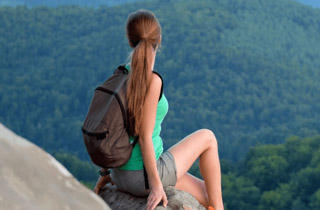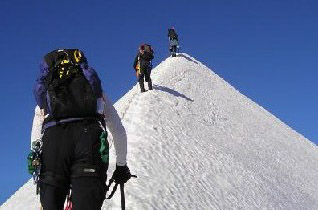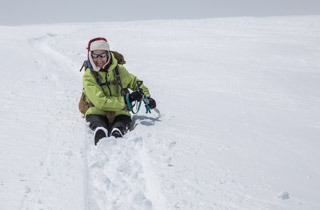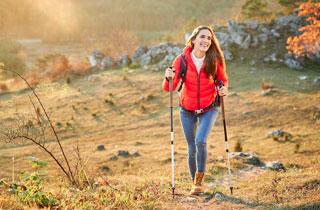Hiking Strength and Mobility
Hiking Strength and Mobility
To improve your balance and enhance your lower body strength and endurance, as well as mobility, for hiking, explore a few of our favorite movements in the following articles.
Including resistance training in your workout program adds all sorts of benefits from increased bone density, a boost to your metabolism, more muscle definition, and best of all, ease in doing everyday tasks. Plenty of strength exercises require nothing more than your own body as resistance. However, for some exercises, body weight can be too much (i.e. pull-ups, particularly for women) or not enough (i.e. squats).
Whenever possible, we recommend training with free weights rather than machines to integrate the working muscles as a whole, and to prepare the body for the three-dimensional challenges of your sport. When you work with free weights, you must balance the weight in all dimensions. Such training loads the spine just as you would on a trail, playing field, slope, or rock wall, rather than moving an attached object while you are supported sitting, leaning, or lying down.
If you want to add resistance training to your program, explore the following options to find what works best for you.
If abdominal crunches are not giving you the results you want, try a functional core strengthening exercise that works your obliques, thighs, lower back, glutes, and shoulders. It resembles digging dirt or shoveling snow, and with little or no weight, it can also be included in a dynamic warm-up before you begin your sport or activity. As always, make sure you have warmed up and stretched for 5-10 minutes before trying any new strength training exercises.
What You Need
You will need a fairly heavy dumbbell, but you can also use a full one-gallon jug (7 pounds), suitcase, backpack, or another weighted object.

Performance of the Dirt Digger exercise
The gluteus maximus and medius are two strong buttocks muscles that contribute to forward and upward propulsion, as well as lateral and sideways motion. The gluteus maximus and hamstrings are recruited in forward bending movements that involve extending the hip, such as in step-ups, good mornings, squats, lunges, and deadlift variations.
The gluteus medius, on the other hand, steadies the pelvis so it does not rotate downwards or droop when you lift the opposing side or stand on one leg. It also assists with moving the thigh outward while keeping the hip still. The gluteus medius lies on the side of the hip directly above the larger gluteus maximus.
The gluteus medius can get neglected when we spend long amounts of time sitting, or if we focus on more quadriceps-dominant activities such as running and cycling. Sometimes knee pain can be caused by overusing quadriceps muscles when the glutes don’t fire properly.
If you experience discomfort in your knees, particularly going down hills or stairs, you may have a muscle imbalance between the vastus lateralis and vastus medialis obliquus (VMO) quadriceps muscles, quad-hamstring ratio, ankle issues, or issues in your hips.

There are several things you can try, including strengthening all the muscles around your knees. An exercise we recommend trying is the VMO Reverse Step-up pictured above and demonstrated in the video below.
If you suffer from any tingling or numbness sensation that runs from the lower back to your buttocks, sometimes even radiating down the leg and/or into the foot, you may find relief in stretching the piriformis muscle.
The piriformis is located deep in the hip and close to the sciatic nerve. The term “piriformis syndrome” is used whenever the piriformis muscle becomes tight or inflamed, which can cause irritation or pinching of the sciatic nerve.
Stretching the piriformis muscle can help relieve discomfort along the sciatic nerve. Try performing one or more of the following stretches for the piriformis and gluteal muscles to help decrease the painful symptoms along the sciatic nerve and increase the comfortable range of motion about the hip joint.
If you are seeking strengthening exercises that will also help you develop balance, try these variations on the classic lunge: lunge step-ups, overhead dumbbell lunges, and tiptoe walking lunges.
All three can be included in a gym or home training routine as they require little more than an adjustable step and some light hand weights. All three exercises focus on the entire leg, including the quadriceps and hip flexors of the back leg, hamstrings, and gluteals of the forward leg, and abductors and adductors for stabilization.
They also engage the abdominals, obliques, and lower back muscles. The overhead dumbbell lunge is also effective in providing some isometric training for the muscles of the shoulders and arms.






